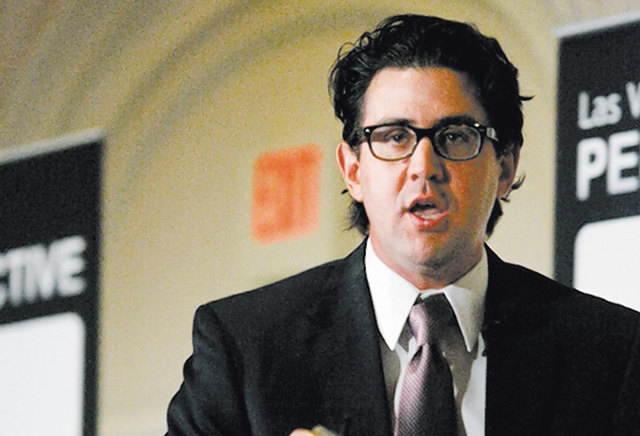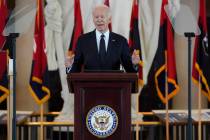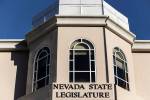Insurance industry study: Nevada margins tax would hurt consumers
Nevadans could face $60 million in higher annual insurance premiums for car, home, life and health policies if a proposed 2 percent margins tax on business is approved by voters in November, an industry-backed study reported Tuesday.
The study was done by Applied Analysis, an independent group that has done previous margin tax studies, but backers of the Education Initiative, or Question 3 on the Nov. 4 ballot, question its figures.
Michael Geeser, president of the Nevada Insurance Council, which commissioned the study, said Nevada insurance companies and consumers already pay the highest premium taxes in the nation, or $240 million a year. The premium taxes go into the state’s general fund and are the third-largest revenue source behind sales and gaming taxes.
“That is a cost that ultimately will be paid by Nevada consumers,” Geeser said.
Jeremy Aguero, who conducted the Applied Analysis study, said the consumer impact depends on insurance companies.
“While some businesses would be forced to absorb the additional tax, there are certainly cases where the additional tax would be passed along to consumers in the form of price increases,” Aguero wrote. “Examples of where a significant share of the increase in costs would be borne by consumers include insurance and utility cost increases.”
Aguero said nearly 10 percent of the margins tax revenues would come from insurance companies and their customers. The study suggested several other industries would be hit even harder, with the retail trade in the No. 1 spot, followed by accommodations, investment/management companies, real estate and then the insurance industry in the No. 5 position.
The Nevada State Education Association, the teachers union, patterned the proposed margins tax after one in Texas, which has a lower rate of 0.5 percent. Nevada’s 2 percent margins tax rate would apply to revenues of any business operating in the state that makes more than $1 million a year. Proponents say about 13 percent of Nevada companies would have to pay the levy whether or not they’re making a profit.
Texas is the only state in the nation that has a margins tax, but insurance companies and their consumers are excluded from paying the levy, according to the study.
The Nevada ballot question is called the Education Initiative because its proceeds are to go into the State Distributive School Account in the state’s general fund.
Critics contend there is no guarantee education funding would increase because the governor and the Legislature could cut the amount of general fund money dedicated to education, shifting the money to other budget needs. The tax’s backers contend lawmakers wouldn’t go against voters’ wishes to boost education funding.
Ruben Murillo Jr., president of the Nevada State Education Association, said the Applied Analysis study “admits it is an ambiguous perspective based on what-ifs.”
“This statement by big insurance is nothing but a bully tactic based on hypotheticals designed to enable it to avoid paying its fair share,” Murillo said. “Voters will see through these deceptive tactics when they vote to pass the Education Initiative in November.”
Dan Hart, a political consultant for the Education Initiative PAC, also dismissed the study as exaggerated.
“This is another study, paid for by one of the industries that want to defeat the Education Initiative, that threatens dire economic consequence from funding education,” Hart said. “Their assumption of the amount raised by the tax has already been proven incorrect by the Guinn Report so this conclusion is incorrect and deceptive.”
The new Guinn Center for Policy Priorities is named for the late Gov. Kenny Guinn, a moderate. It bills itself as a nonprofit think tank that will produce analysis on “critical policy issues facing the state of Nevada.”
“The voters will not be fooled by these big insurance companies whose last keen idea was the credit default swaps that caused the Great Recession,” Hart added.
Estimates on how much money the margins tax could raise each year — and how much businesses would have to pay — have ranged from $400 million to $750 million. The Nevada State Education Association has put the figure at $400 million. The new Guinn Center reports it could raise $460 million. Applied Analysis estimated a range of $650 million to $750 million.
Other supporters of the margins tax also slammed the study.
“The insurance industry’s study on insurance rates increasing is another doomsday opinion meant to scare voters from supporting the Education Initiative,” said Annette Magnus, executive director of ProgressNow Nevada Action, a group formed to support the proposed tax. “It is the same ‘the sky will fall’ argument we hear when we talk about raising the minimum wage.”
But Karen Griffin, spokeswoman for the Defeat the Nevada Margin Tax Initiative, said the study is another piece of evidence showing what dire effects the new levy could have on the state’s economy and Nevada taxpayers.
“The study released today by the Nevada Insurance Council further proves that the Margin Tax Initiative would hurt Nevada consumers and damage our fragile economy,” Griffin said. “The insurance industry would be one of the hardest hit sectors and Nevada families would bear the brunt of this costly tax proposal.”
Republican Gov. Brian Sandoval has led the fight against the proposed margins tax, saying it would deliver a “fatal blow” to many small businesses and set up a roadblock to Nevada’s economic recovery.
The new study is online at: http://nevadainsurancecouncil.com/study-margin-tax-hits-consumers-with-60-million-in-higher-insurance-rates/#more-311.
Contact reporter Laura Myers at lmyers@reviewjournal.com or 702-387-2919. Follow her on Twitter @lmyerslvrj.




























